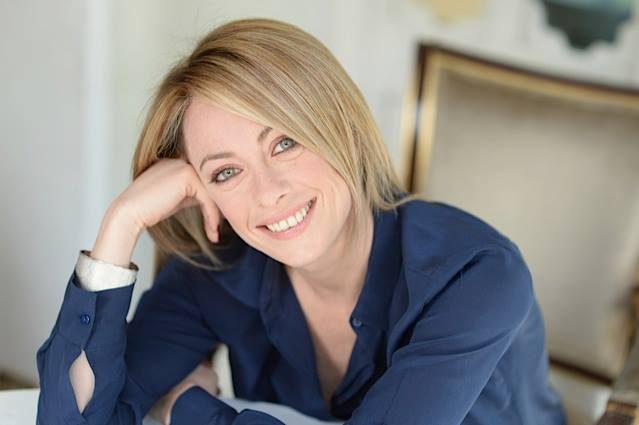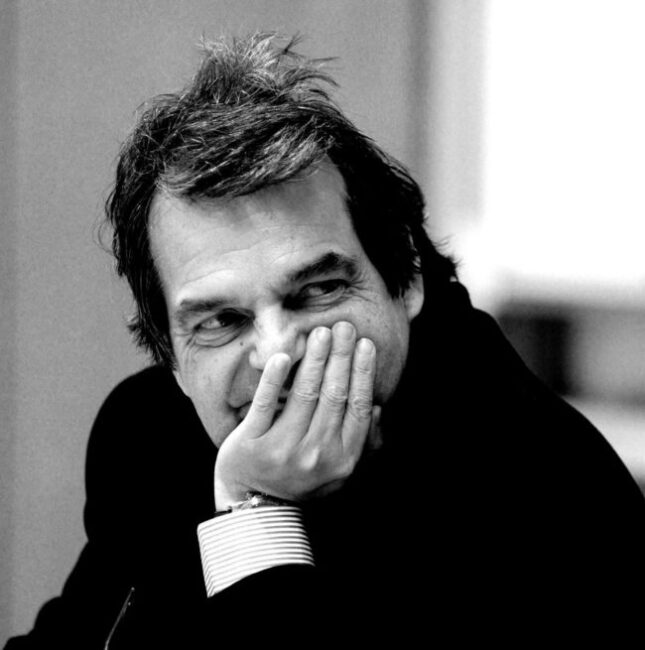La creatività di alcuni artisti si manifesta in modi differenti, a volte persino discostanti, perché spesso i creativi sono divisi tra due anime, quella più impulsiva che necessita di esprimersi con immediatezza in totale assenza di controllo da parte del lato razionale, e quella invece che mostra un maggiore bisogno di legarsi alla realtà, di avere un approccio più concreto e dunque figurativo, pur lasciando l’immaginazione e l’emozione fluire sulla tela proprio per quel soffermarsi su scorci e dettagli di un ricordo o di un desiderio di essere proprio nel luogo in cui la creatività è stata stimolata a eseguire l’opera. L’artista di cui vi racconterò oggi appartiene esattamente a questo gruppo per il quale attenersi a un solo stile sarebbe limitante per una personalità che necessita sia di lasciarsi andare al puro istinto e sia di mantenere un legame con la parte più visiva, con ciò su cui lo sguardo si posa e da cui resta colpito.
Il Ventesimo secolo ha segnato un profondo cambiamento nella storia dell’arte perché durante il suo corso, in particolar modo nei primi decenni durante i quali si sono susseguite in modo quasi concitato tutte le avanguardie poi successivamente modificate e riproposte negli anni seguenti, si sono generati e hanno convissuto stili completamente differenti, in cui tutto ciò che era essenziale per l’uno poteva essere completamente sovvertito e annullato dall’altro. Questa convivenza ha dato modo a molti artisti di evolvere e di aderire, nel corso della loro carriera, a diversi movimenti, tutti estremamente importanti eppure a volte persino dissonanti. Pablo Picasso da un inizio espressionista, a cui appartengono i suoi celeberrimi Periodo blu e Periodo rosa, ha poi cominciato a viaggiare restando affascinato dalle maschere africane mescolando così il Primitivismo al tema della scomposizione, che in lui si concretizzò attraverso la geometricità delle figure rappresentate dando così vita al Cubismo per poi orientarsi, dopo il secondo dopoguerra, verso un ritorno all’ordine con un inaspettato Neoclassicismo. Henri Matisse fu tra i maestri che più ruppero schemi e oltrepassarono barriere poiché da fondatore del movimento dei Fauves, a cui appartengono le sue prime opere più famose, si spostò gradualmente verso un Espressionismo stilizzato e tendente sempre di più, soprattutto negli ultimi anni della sua vita, a un rifiuto della figurazione che si concretizzò in opere astrattiste supportate anche dall’utilizzo di collage. Persino Jackson Pollock, tra i fondatori dell’Espressionismo Astratto nonché simbolo di quella nuova arte completamente impulsiva e immediata, ebbe un passato figurativo, prima decisamente espressionista, poi con divagazioni verso il Cubismo per poi approdare a quello che fu lo stile in virtù del quale divenne celebre a livello planetario. E ancora Gerard Richter, altro immenso esponente dell’Espressionismo Astratto contemporaneo, che ebbe un passato obbligatoriamente figurativo poiché nella Germania dell’Est prima dell’unificazione l’Astrattismo era considerato osceno e dunque fuorilegge, in un secondo momento, dopo aver realizzato la sua fuga verso ovest, passò a un coraggioso Espressionismo in cui cancellava i dettagli figurativi dei suoi ritratti in bianco e nero, quasi a voler gridare il suo bisogno di abbandonare la figura per tendere verso quella che sentiva essere la sua naturale inclinazione, cioè l’indefinitezza e la non forma e soprattutto il colore non come coadiuvante nella resa della realtà bensì semplicemente come espressione dell’anima.
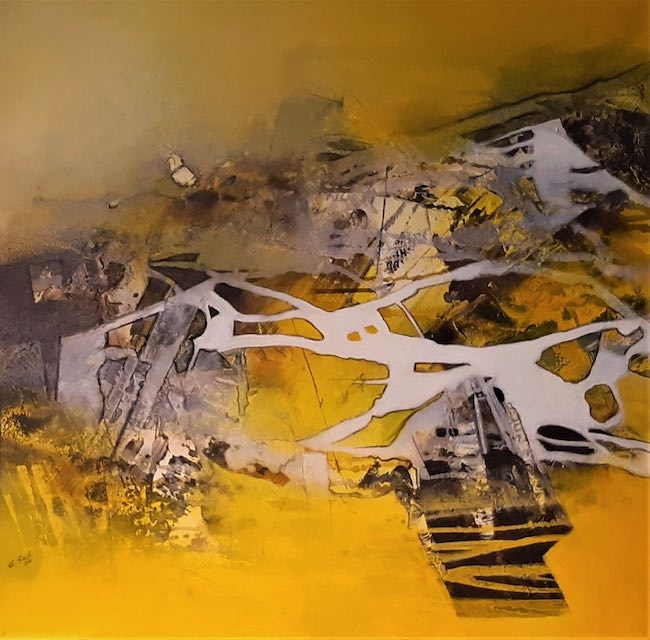
L’artista austriaca Christiana Rassl, contemporanea e pertanto cresciuta nel concetto attuale di poter anche esprimere differenti istinti creativi senza per questo sentir messa in dubbio la propria identità creativa, sceglie di strutturare la sua produzione dividendosi tra Espressionismo Astratto ed Espressionismo Urbano, perché da un lato ha bisogno di lasciarsi andare all’impulso, quel motore incontenibile che le permette di giocare con i colori e con i materiali senza alcun confine da parte della realtà, mentre dall’altro la sua memoria, o la sua immaginazione, hanno bisogno di perdersi dentro scorci cittadini che la affascinano e che costituiscono il suo sogno, un ideale paesaggio urbano in cui la moltitudine diviene una semplice cornice della maestosità e dello scintillio di metropoli come quelle statunitensi.
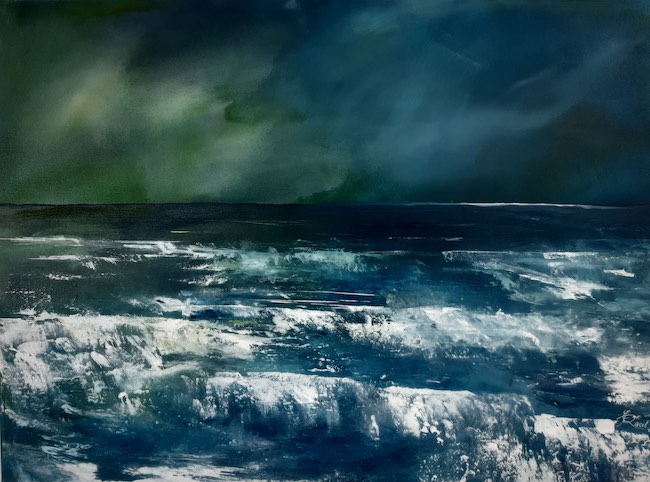
Dal punto di vista della formazione Christiana Rassl ha cominciato fin da bambina a seguire la sua inclinazione artistica, lavorando il metallo, dipingendo la porcellana ed eseguendo disegni in bianco e nero; dopo un lungo periodo di distacco dall’arte durante il quale ha dato la priorità alla sua carriera professionale e alla famiglia, ha avvertito l’esigenza di ricominciare a dare libero sfogo al lato creativo seguendo corsi di acquarello sia in Austria che all’estero, grazie ai quali si è specializzata sia su quella tecnica, che successivamente sulla pittura acrilica.
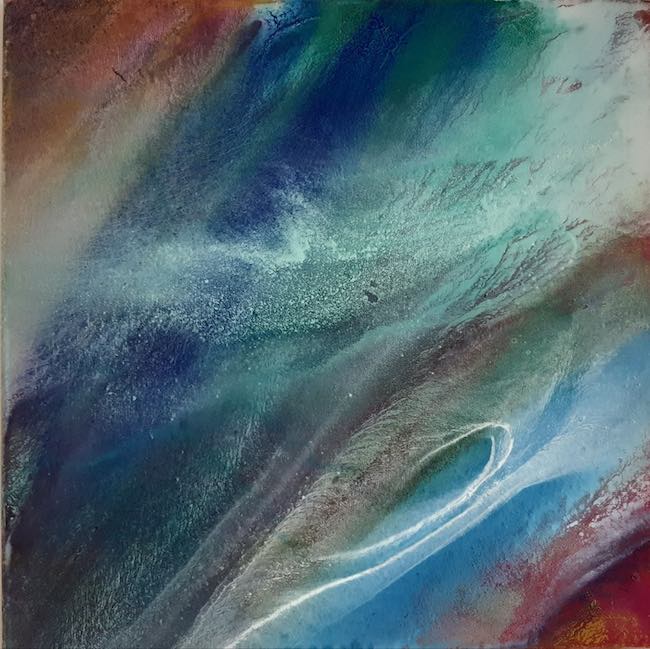
Dunque spesso le sue tele sono in tecnica mista dove le due tecniche che ama sono mescolate per aumentare la suggestione generata dall’Espressionismo Astratto che la contraddistingue, un misto di evocazioni soffuse di ricordi, di paesaggi che si confondono dentro la non forma pur mantenendo un leggero contatto con la figurazione, come se nell’universo di Christiana Rassl tutto avesse dei confini sfumati, come se ciò che contasse per lei non fosse il dettaglio bensì l’emozione che dall’osservazione di un singolo elemento scaturisce, o è scaturita, nel momento in cui il suo sguardo si è lasciato andare e si è perso nell’immagine.
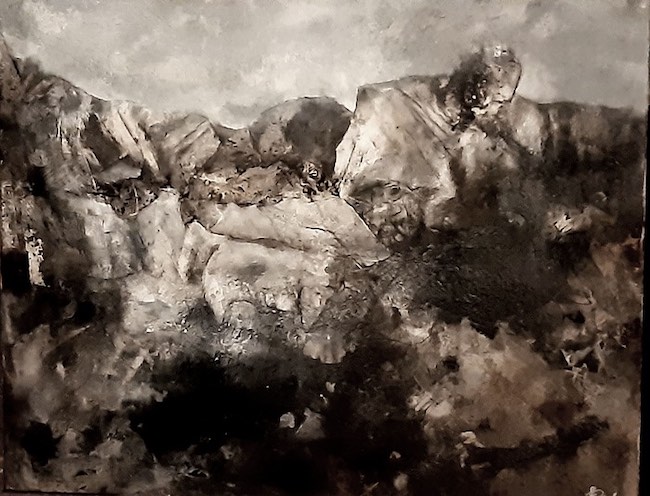
Nella tela Gebirge, schau genau (Montagna, guarda con attenzione) infatti, la montagna evocata nel titolo è solo immaginabile proprio perché l’artista desidera confondere l’osservatore, non vuole dargli troppi elementi riconoscibili per spingerlo a percepire il respiro della natura, a rispettarne i segreti e i misteri avvicinandosi a lei attraverso le sensazioni, perdendosi nel suo lato più impervio ma al tempo stesso approfittare del silenzio, dell’aria leggera, e inducendolo a prendere coscienza dell’esiguità dell’essere umano di fronte a tanta maestosità. Forse è proprio per evidenziare questa sensazione che le tonalità del dipinto sono scure, terrose. La gamma cromatica si modifica invece quando Christiana Rassl sceglie di raccontare il mare, la schiuma delle onde, l’irruenza delle tempeste che a volte lo contraddistinguono, dunque pur costituendo a sua volta una sorta di monito per l’uomo a essere consapevole della limitatezza e fragilità della sua esistenza rispetto alle forze naturali, i colori si schiariscono, si assecondano alle acque che anche quando sono impetuose infondono sempre una sensazione meno cupa o apparentemente meno minacciosa rispetto alla montagna dell’opera precedentemente descritta.
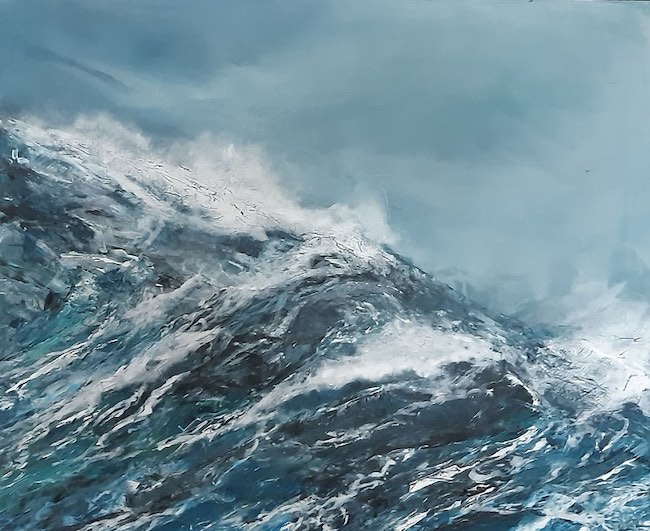
Il dipinto Schaumkronen (Corone di schiuma) dunque, da un lato ha i colori dell’acqua ma dall’altro ha la medesima apparenza indefinita che è segno distintivo della Rassl perché in fondo l’interiorità non ha bisogno di aggrapparsi all’osservato per comprendere, piuttosto solo quando si distacca dalla realtà è in grado di ascoltarsi con maggiore attenzione e profondità. Ma l’anima dell’artista ha bisogno anche di rientrare nella contingenza a volte, perché in fondo la contemporaneità richiede di essere osservata e ammirata nelle sue evoluzioni e nella sua magnificenza, dunque si sposta verso l’Espressionismo per rappresentare a suo modo e con la sua interpretazione, quelle metropoli urbane che appartengono all’immaginario collettivo, quei luoghi dove tutto è possibile, dove la mano dell’uomo ha costruito panorami precedentemente inimmaginabili, grattacieli, luci sfavillanti, brulicanti di vita proprio per le opportunità che le grandi città, in particolar modo quelle statunitensi, da sempre offrono.
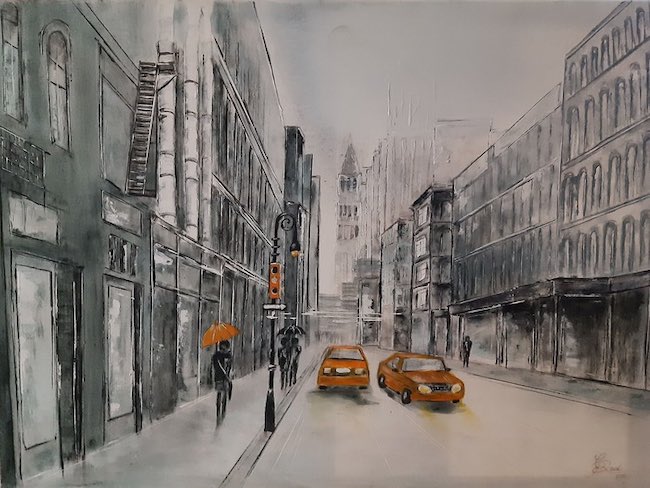
Ecco dunque che il tratto pittorico della Rassl si fa figurativo nelle tele in cui racconta della sua ammirazione per la Grande Mela, protagonista di due opere, Strasse in New York (Strada a New York), dove l’attenzione si focalizza sul giallo dei taxi, dei semafori e dell’ombrello di una passante, come se solo quei piccoli dettagli fossero in grado di mettere in secondo piano il grigio dei palazzi, dei marciapiedi e del cielo plumbeo carico di pioggia; in Times Square al contrario la città appare più vivace, sembra pavoneggiarsi davanti allo sguardo dell’osservatore con i colori dei suoi tabelloni pubblicitari e con la varietà della moltitudine di persone che affollano la grande piazza.

La sensazione che emerge è ancora una volta quella dell’inconsistenza dell’essere umano che di fatto è solo di passaggio rispetto alle sue stesse creazioni che invece restano e attraversano i secoli. Christiana Rassl ha al suo attivo molte mostre collettive in Austria, Svizzera e Bulgaria ed espone periodicamente le sue opere presso la City Gallery Vienna.
CHRISTIANA RASSL-CONTATTI
Email: christiana.rassl@gmx.at
Facebook: https://www.facebook.com/profile.php?id=100071236860593
Instagram: https://www.instagram.com/christianarassl/
From watercolour to acrylic with the art of Christiana Rassl, when Abstract Expressionism reaches out for figuration
The creativity of some artists manifests itself in different, sometimes even discordant ways, because creatives are often divided between two souls, the more impulsive one that needs to express itself with immediacy in the total absence of control by the rational side, and the one that shows a greater need to connect with reality, to have a more concrete and therefore figurative approach, while allowing imagination and emotion to flow on the canvas precisely because of that lingering on glimpses and details of a memory or a desire to be in the very place where creativity was stimulated to execute the artwork. The artist I am going to tell you about today belongs precisely to this group for whom sticking to one style would be limiting for a personality that needs both to let go of pure instinct and to maintain a connection with the more visual side, with what the eye rests on and is struck by.
The 20th century marked a profound change in the history of art because during its course, particularly in the first decades during which all the avant-gardes followed one another in an almost frenzied manner, then subsequently modified and re-proposed in the following years, were generated and coexisted completely different styles, in which everything that was essential to one could be completely subverted and annulled by the other. This coexistence gave many artists the opportunity to evolve and to adhere, in the course of their careers, to different movements, all extremely important and yet sometimes even dissonant. Pablo Picasso, from an expressionist beginning, to which his famous Blue Period and Pink Period belong, then began to travel, being fascinated by African masks, thus mixing Primitivism with the theme of decomposition, which in him was realised through the geometricity of the figures represented, thus giving rise to Cubism, and then after the Second World War turned towards a return to order with an unexpected Neoclassicism. Henri Matisse was among the masters who most broke schemes and crossed barriers, as from being the founder of the Fauves movement, to which his most famous early artworks belong, he gradually moved towards a stylised Expressionism that tended more and more, especially in the last years of his life, towards a rejection of figuration that took the form of Abstract works also supported by the use of collage. Even Jackson Pollock, one of the founders of Abstract Expressionism as well as a symbol of that new, completely impulsive and immediate art, had a figurative past, at first decidedly expressionist, then with digressions towards Cubism and then moved on to what was the style by virtue of which he became world famous. And again Gerard Richter, another immense exponent of contemporary Abstract Expressionism, who had a compulsorily figurative past because in East Germany before unification, Abstractionism was considered obscene and therefore outlawed, and later, after his escape to the West, he switched to a courageous Expressionism in which he erased the figurative details of his black and white portraits, almost as if to shout out his need to abandon the figure in order to tend towards what he felt to be his natural inclination, namely indefiniteness and non-form and above all colour not as an aid in the rendering of reality but simply as an expression of the soul. The Austrian artist Christiana Rassl, who is contemporary and therefore grew up with the current concept of being able to also express different creative instincts without feeling her own creative identity called into question, chooses to structure her production between Abstract Expressionism and Urban Expressionism, because on the one hand she needs to let go of the impulse, that irrepressible motor that allows her to play with colours and materials without any boundaries from reality, while on the other her memory, or her imagination, needs to lose itself in city views that fascinate her and that constitute her dream, an ideal urban landscape in which the multitude becomes a simple frame for the majesty and glitter of metropolises such as those in the United States. In terms of education, Christiana Rassl started as a child to follow her artistic inclination, working with metal, painting porcelain and executing black and white drawings. After a long period of detachment from art during which she gave priority to her professional career and family, she felt the need to give her creative side free rein again by taking watercolour courses both in Austria and abroad, thanks to which she specialised both in that technique and later in acrylic painting.
Thus, her canvases are often mixed media where the two techniques she loves are mixed to increase the suggestion generated by the Abstract Expressionism that distinguishes her, a mixture of suffused evocations of memories, of landscapes that blend into the non-form while maintaining a slight contact with figuration, as if everything in Christiana Rassl‘s universe had blurred boundaries, as if what mattered to her was not the detail but the emotion that arises, or arose, from the observation of a single element at the moment when her gaze let itself go and got lost in the image. In the canvas Gebirge, schau genau (Mountain, look carefully) in fact, the mountain evoked in the title is only imaginable precisely because the artist wishes to confuse the observer, does not want to give him too many recognisable elements in order to encourage him to perceive the breath of nature, to respect its secrets and mysteries by approaching it through sensations, losing oneself in its most impervious side but at the same time taking advantage of the silence, of the light air, and inducing him to become aware of the smallness of the human being in the face of such majesty. Perhaps it is precisely to emphasise this feeling that the painting’s tones are dark, earthy. On the other hand, the chromatic range changes when Christiana Rassl chooses to depict the sea, the foam of the waves, the impetuosity of the storms that sometimes characterise it, therefore, while in turn constituting a sort of warning for man to be aware of the limitedness and fragility of his existence in relation to natural forces, the colours lighten, going along with the waters that even when they are impetuous always instil a less gloomy or apparently less threatening sensation than the mountain in the artwork previously described. The painting Schaumkronen (Crowns of Foam) therefore, on the one hand has the colours of the water but on the other has the same indefinite appearance that is Rassl‘s hallmark because after all, the inner self does not need to cling to the observed in order to understand, rather only when it detaches itself from reality is it able to listen to itself with greater attention and depth.
But the artist’s soul also needs to re-enter contingency at times, because after all, contemporaneity demands to be observed and admired in its evolutions and magnificence, so she moves towards Expressionism to represent in her own way and with her own interpretation those urban metropolises that belong to the collective imagination, those places where everything is possible, where the hand of man has built previously unimaginable panoramas, skyscrapers, glittering lights, teeming with life precisely because of the opportunities that large cities, especially those in the United States, have always offered. Here, Rassl‘s pictorial stroke becomes figurative in the canvases in which she tells of her admiration for the Big Apple, the protagonist of two paintings, Strasse in New York (Street in New York), where the focus is on the yellow of taxis, traffic lights and a passer-by’s umbrella, as if only those small details were able to overshadow the grey of the buildings, the pavements and the leaden sky laden with rain; in Times Square, on the contrary, the city appears more lively, seems to strut before the observer’s gaze with the colours of its billboards and the variety of the multitude of people crowding the large square. The feeling that emerges is once again that of the insubstantiality of the human being who is in fact only passing through compared to his own creations, which instead remain and cross the centuries. Christiana Rassl has many group exhibitions in Austria, Switzerland and Bulgaria to her credit and periodically exhibits her works at the City Gallery Vienna.











